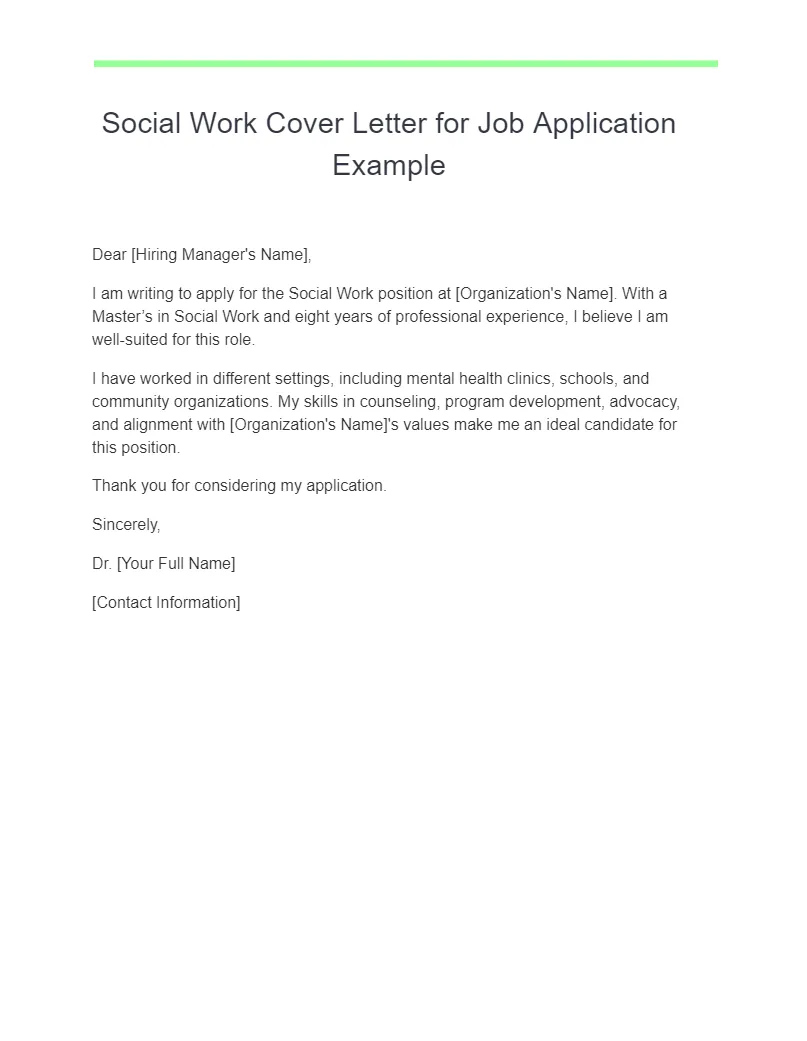Understanding the Importance of a Social Worker Cover Letter
A well-crafted cover letter is your first chance to make a positive impression on a potential employer. For social workers, whose profession centers on building relationships and demonstrating empathy, a cover letter serves as a critical tool to showcase your personality, qualifications, and genuine interest in the position. It goes beyond the information presented in your resume, allowing you to tell a compelling story about why you are the perfect fit. A cover letter for a social worker position isn’t merely a formality; it’s a powerful platform to demonstrate your commitment to helping others and your understanding of the specific organization and its mission. A strong cover letter is a key to getting your foot in the door and securing an interview, which can lead to your dream job.
Key Components of a Strong Social Worker Cover Letter
A successful social worker cover letter contains several key elements that work in concert to highlight your suitability for the role. These elements work together to convince the hiring manager that you possess not only the necessary skills and experience but also the compassion, dedication, and values essential for this profession. Each section is vital in presenting a well-rounded image of you and demonstrating your understanding of the requirements of the social worker position and the organization’s goals. Make sure all components are clear, concise, and professional.
Contact Information
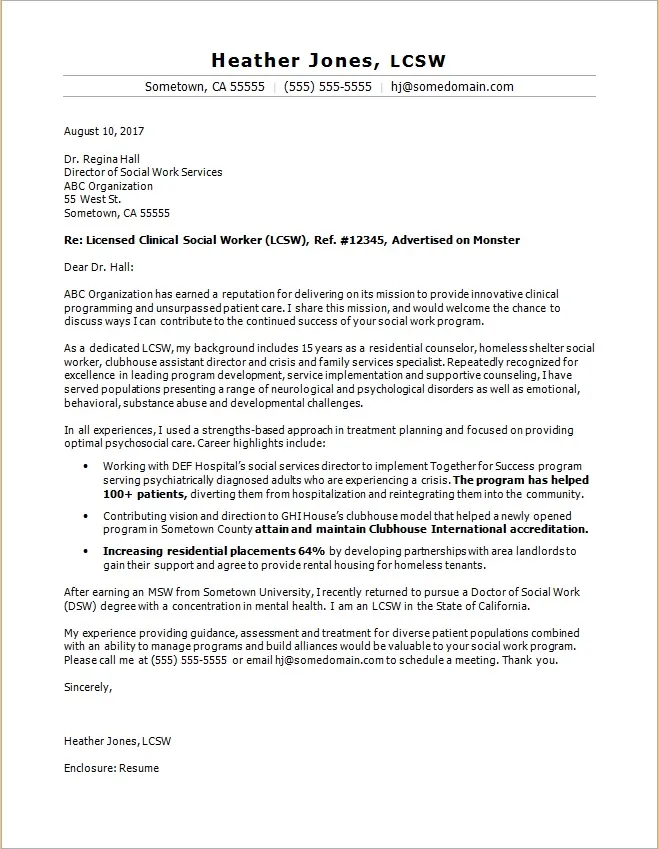
At the top of your cover letter, include your full name, phone number, professional email address, and LinkedIn profile (optional). Ensure the information is accurate and up-to-date. Using a professional email address is crucial. Double-check all contact details to make it easy for the employer to reach you for an interview or to request further information. Including your LinkedIn profile allows the hiring manager to learn more about your professional background and network.
Personalized Greeting
Address the hiring manager by name if possible. Research the organization to find the name of the hiring manager or the person responsible for reviewing applications. If you cannot find a specific name, use a professional greeting such as “Dear Hiring Manager.” Avoid generic greetings like “To Whom It May Concern.” A personalized greeting shows that you have taken the time to research the organization and are genuinely interested in the position. It is the first step in establishing a connection with the hiring manager, setting a more personal tone and showing you are attentive to detail.
Highlighting Your Skills and Experience
This is the core of your cover letter where you showcase your qualifications. Carefully review the job description and identify the key skills and experiences the employer is seeking. Use specific examples from your past experiences to demonstrate how you have successfully applied those skills. Quantify your achievements whenever possible, for instance, by stating the number of clients you’ve served or the percentage by which you improved a program. Focus on what makes you stand out as a candidate. This section aims to convince the hiring manager that you meet and exceed the requirements of the position.
Relevant Qualifications
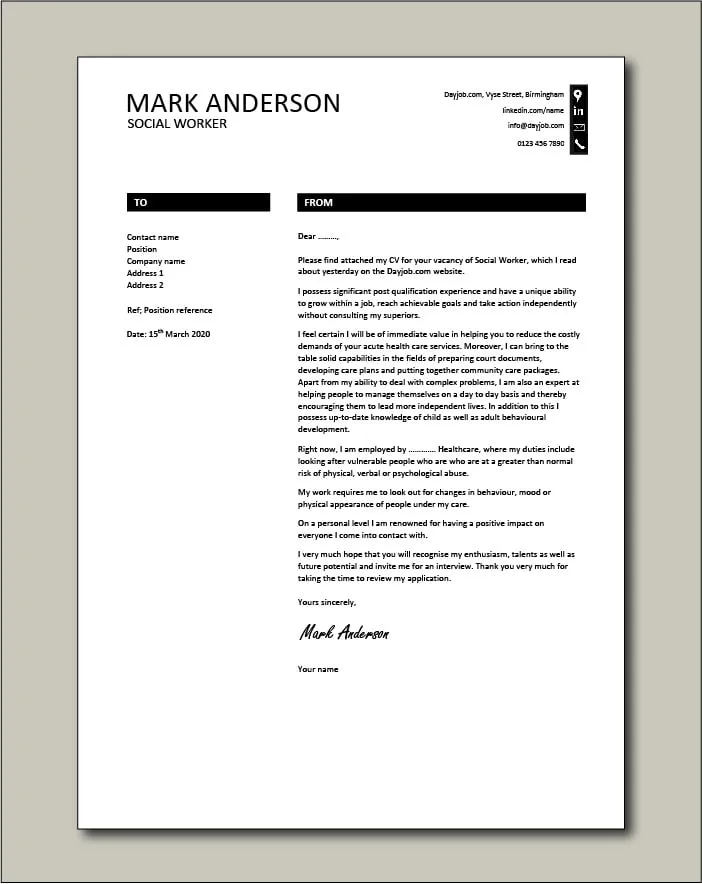
Detail your relevant qualifications, such as your degree in social work (BSW, MSW), any licenses or certifications (e.g., LCSW, LSW), and specialized training or knowledge. Tailor this section to match the job description’s requirements. If the position emphasizes experience with a specific population (e.g., children, the elderly, veterans), ensure you clearly highlight your relevant experience. Provide concrete evidence of your proficiency by discussing any past relevant responsibilities and the specific tasks you performed, rather than simply listing the job titles.
Impactful Achievements
Instead of just listing your responsibilities, focus on your achievements. For example, if you improved client outcomes, increased program participation, or secured grant funding, provide specific details. Use the STAR method (Situation, Task, Action, Result) to frame your examples. Describe the situation, the task you were assigned, the action you took, and the positive results you achieved. Quantify your achievements whenever possible to demonstrate the impact you made. For example, “Implemented a new counseling program that increased client satisfaction by 25%.” Emphasizing your achievements is key to standing out from other applicants.
Demonstrating Your Passion and Values
Social work is a profession driven by empathy, compassion, and a commitment to helping others. In your cover letter, express your genuine passion for the field. Explain why you are drawn to social work, what motivates you, and the values that guide your work. Briefly discuss your commitment to ethical practice and the importance of social justice. The ability to articulate your passion will help the hiring manager understand your dedication and your alignment with the organization’s mission. Share personal experiences or motivations that have led you to choose this career.
Showcasing Your Understanding of the Organization
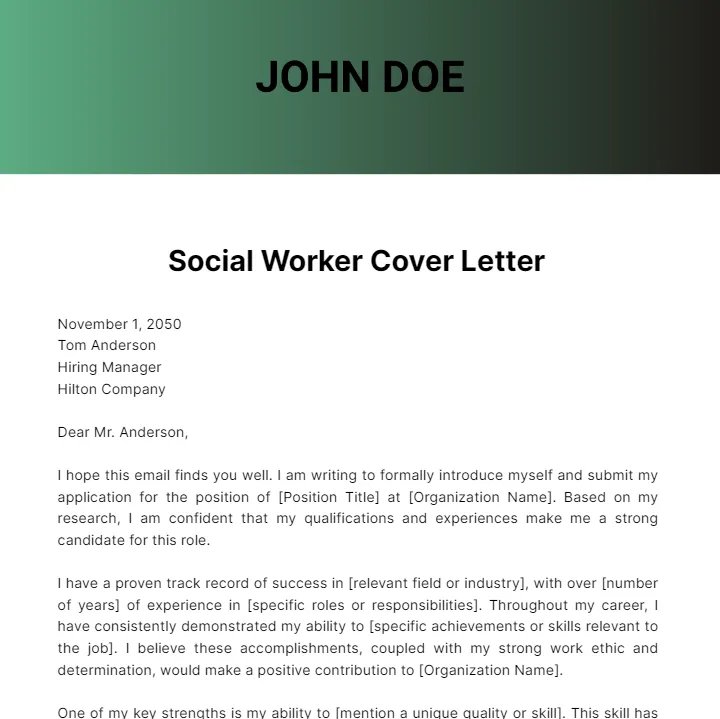
Before writing your cover letter, research the organization thoroughly. Understand its mission, values, the populations it serves, and its recent achievements. In your cover letter, demonstrate that you have a clear understanding of the organization’s work and explain why you want to be part of it. Tailor your letter to the specific organization, mentioning its programs, services, or recent initiatives that resonate with your interests and skills. Highlighting this kind of detailed research shows your sincere interest and that you are not simply submitting a generic application.
Call to Action and Closing
In your closing paragraph, reiterate your interest in the position and express your enthusiasm for an interview. Make it easy for the hiring manager to contact you by restating your contact information. Thank the hiring manager for their time and consideration. End with a professional closing such as “Sincerely” or “Best regards,” followed by your name. A strong call to action encourages the hiring manager to take the next step and consider your application further. This reinforces your enthusiasm and helps move the application process along.
Formatting and Proofreading Your Cover Letter
A well-formatted and error-free cover letter makes a professional impression and demonstrates your attention to detail. Poorly formatted cover letters that contain spelling or grammatical errors could prevent you from securing an interview. Ensure your letter is easy to read and free of mistakes.
Formatting Guidelines
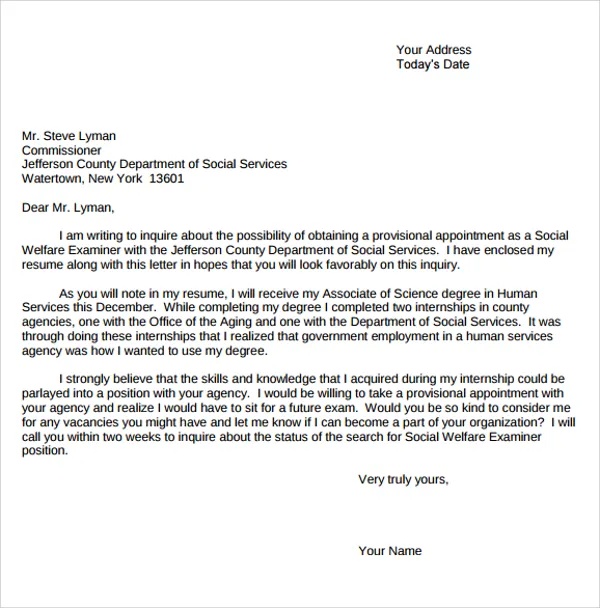
Use a professional font such as Times New Roman, Arial, or Calibri in size 11 or 12 points. Maintain a standard one-inch margin on all sides of the page. Use single-spacing within paragraphs and double-spacing between paragraphs. Keep the letter concise, ideally within one page. Use clear and concise language to avoid confusion. Break up large blocks of text by using paragraphs to improve readability. Use bullet points to highlight key skills or accomplishments.
Proofreading Tips
Carefully proofread your cover letter multiple times. Check for spelling, grammar, punctuation, and formatting errors. Use spell-check and grammar-check tools, but also manually review the document to catch errors that automated tools may miss. Ask a friend, family member, or career advisor to proofread your cover letter for a fresh perspective. They may be able to spot mistakes that you have overlooked. Proofreading will help you avoid making a negative impression.
Tailoring Your Cover Letter to Specific Positions
While a basic cover letter template can be a starting point, it is crucial to tailor each letter to the specific job you are applying for. Review the job description carefully and identify the key requirements, skills, and experiences the employer is seeking. Use the job description keywords throughout your cover letter to demonstrate that you meet the requirements. Highlight how your skills and experience match the specific needs of the position and the organization. Customizing your cover letter makes it more relevant and increases your chances of success, showing employers you’ve researched the role.
